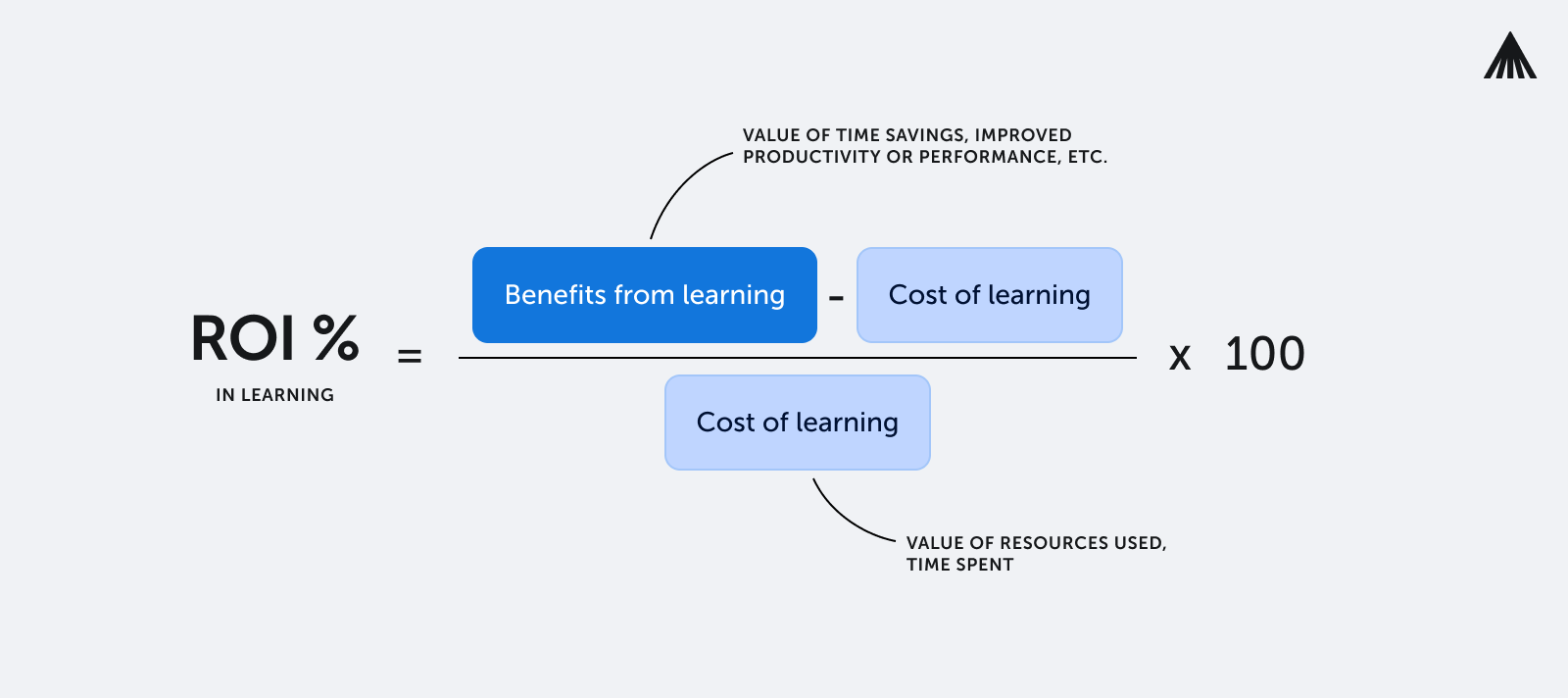L&D ROI: 3 strategies for convincing management to invest in modern learning technology
Explore how to measure ROI in learning and development and gain insights into training ROI to persuade management on tech learning investments.

L&D ROI is more than a buzzword—it’s the key to turning Learning and Development (L&D) from a perceived cost center into a proven value driver. Yet many companies still see L&D as just a checkbox for onboarding or compliance.
To get executive buy-in for new learning technologies and initiatives, L&D professionals need to demonstrate clear, measurable returns.
From reducing turnover to boosting productivity and enabling reskilling, a strategic L&D program—powered by the right tools—can deliver real business impact and a strong return on investment.
Discover:
- How to measure ROI
- Why do you need to measure ROI in your L&D initiatives?
- The benefits of investing in modern learning technologies
- 3 strategies to convince management to invest
What is L&D ROI?
Return on Investment (ROI) tracks the value generated by L&D initiatives compared to the money spent on the initiative. It seems straightforward, right? But there’s more to it than meets the eye. Let’s break it down.
How to measure ROI (%) in L&D
Here’s the formula:
Learning ROI (%) = 100 x (Benefits from Learning – Cost of Learning) / Cost of Learning

Costs of learning
Figuring out the “cost of learning” part is usually pretty clear-cut. It’s all about tallying up the resources for the training and the time spent by everyone involved.
Benefits from learning
“Benefits from learning” is a different story. L&D brings a mix of tangible and intangible benefits.
Tangible benefits: easier to track
- Time savings through streamlined processes, improved productivity, or learning new systems.
- Enhanced employee performance, leading to increased sales, better customer satisfaction and retention, and safer work environments.
Intangible benefits: harder to measure
- Higher employee satisfaction which leads to better succession planning, reduced turnover, and retention of crucial institutional knowledge.
- The degree to which training translates into workplace skills.
- Upskilling and reskilling to stay ahead in the industry.
- Boosting soft skills like teamwork and communication across the company.
Pro tips:
- Getting an accurate ROI means separating the impact of learning from other workplace elements. This involves tracking KPIs related to each employee and broader business operations, seeing how they shift before and after training.
- Measuring as you go. You can also monitor learning outcomes as you roll out programs. For instance, train a specific team or department first and compare their performance improvements to those not yet trained. This helps you nail down the benefits of a training program for a more precise ROI calculation.

Is your company set for a digital learning solution?
You can quickly assess strengths, weaknesses, and areas for improvement with the template.
DOWNLOAD checklistWhy do you need to measure ROI in your L&D initiatives?
While training programs have good intentions, there is only so much money to go around, and organizations will want to invest in the most effective programs possible.
Calculating L&D ROI helps businesses:
- Grasp the actual value of different training initiatives.
- Choose which L&D programs to focus on.
- Improve ineffective programs.
- Decide on future training budgets.
- Show management why continuing L&D investment is crucial.
In today’s world, modern L&D teams lean heavily on learning technology to enhance training delivery. This tech requires investment, and convincing management of its value is vital. But remember, the benefits it brings are numerous and significant.
The benefits of investing in learning technologies
1. Enhanced learning experience
Technology is transforming how we approach learning in the workplace. Unlike the traditional classroom setup, where an instructor leads and employees listen, tech-enhanced learning is much more interactive and engaging. The old way can make it challenging for employees to absorb the information.
With tech, L&D becomes far more accessible and flexible. Employees aren’t tied down to a specific location or time. They can access learning materials remotely, fitting them into their schedules as needed.
What’s more, technology offers a variety of ways to learn. Employees can engage with interactive videos, gamified content, social learning tools, and other formats that cater to different learning preferences.
This not only makes the experience more enjoyable but also helps in retaining the information better. It’s a more effective way to learn, and it fits right into the busy world of today’s L&D professionals.
Read: What is the Difference Between LMS and LXP: Which One to Choose
2. Improved learning outcomes
Integrating technology into the learning experiences leads to enhanced outcomes.
This approach boosts knowledge retention and the practical application of new skills in the workplace. Traditional methods, often passive, can lead to a lapse in concentration and a failure to absorb new concepts fully. By infusing technology, you ensure that learners are more engaged, making knowledge stick.
As a result, employees gain relevant information that can be directly applied in their roles, enhancing productivity and equipping them for potential role transitions.
Read: How to Successfully Implement Learning Analytics in Your Company
3. Cost reduction
Although there’s an initial investment, the strategic implementation of learning technology can be more cost-efficient for running L&D programs.
Beyond the obvious benefits, this approach allows you to phase out traditional classroom sessions. E-learning and virtual sessions reduce travel and instructor costs, enabling learning directly from one’s workspace.
Moreover, modern learning technology simplifies the creation of bespoke training materials, which can be reused, providing consistent and relevant training to new and existing employees without incurring extra costs.
4. Data for feedback and assessment
Learning technology offers valuable data for assessing learner performance and the effectiveness of training content. A modern Learning Management System (LMS) is more than a repository; it provides insights into learning patterns and preferences.
This technology facilitates immediate learner feedback on training materials. The integration of assessments into the training process helps gauge content retention.
Moreover, the Learning Experience Platform (LXP) features aid in personalizing training journeys and identifying and addressing each learner’s unique needs. Advanced analytics and machine learning in these platforms suggest optimal training paths, tailoring content based on previous interactions.
All this data elevates the learning experience and provides essential metrics for evaluating the return on investment in L&D.
Read: How to Use LMS Data: Use Cases for Enhancing L&D Insights

Is your company set for a digital learning solution?
You can quickly assess strengths, weaknesses, and areas for improvement with the template.
DOWNLOAD checklist3 Strategies to convince management
Finally, we get to actual actions. We know that L&D teams often face the challenge of demonstrating the value of their operations, particularly in the use of learning technology. We’ve identified specific strategies that are beneficial in situations where budgets are tight.
Here are three strategies to help you make a strong case to management for protecting your L&D budget in future planning.
1. Determining L&D ROI
Management favors numbers. So, you should start from obvious – calculate the ROI of L&D. As we already know, it can be tricky, as it involves measuring various benefits from specific training programs.
To make this easier, focus on three key areas:
- Training effectiveness – evaluate what learners have gained and their reactions. Use feedback forms for learners to assess the program’s value. Consider conducting staff assessments or reviews before and after the training to gauge its impact.
- Knowledge transfer – have employees and their supervisors fill out follow-up feedback forms. This helps determine if the training’s insights are effectively applied in their daily work. Ask them about noticeable improvements linked to recent L&D efforts.
- Business outcomes – identify metrics to track pre-and post-training. These could include sales figures, customer retention rates, incident report frequency, or other relevant data tied to the training program’s objectives.
By focusing on these strategies, you can create a compelling argument for the continued investment in learning technology and L&D initiatives, demonstrating their tangible benefits to the business.
Pro tip: If your company or department is new in learning technology world. Emphasize the cost-effectiveness of these investments compared to traditional training methods. For example, “Our recent L&D initiative resulted in a 120% ROI, proving that investing in learning technologies can generate significant financial returns.”
When sifting through data from L&D initiatives, it’s easy to overstate a training program’s impact. Remember, many factors influence employee performance and overall business success. To get an accurate picture of L&D ROI, you need to separate training effects from other variables. Here are some ways to do this:
- Stagger training sessions – create a control group by staggering training sessions. This lets you compare the performance of trained employees against those who haven’t received training yet. By tracking relevant KPIs across different groups, you can pinpoint the specific impact of your L&D efforts.
- Gather testimonials -use feedback from employees and supervisors to find quantitative measures of training impact. Ask about their experiences with recent training and if they can link any operational improvements to it. Assigning a percentage impact, though not perfect, gives L&D teams a sense of their program’s effectiveness.
- Statistical analysis -while it’s a bit complex for this blog, using statistical methods can identify benefits from training. This requires access to historical business data and an understanding of seasonal trends. Analyzing this data helps forecast future performance, allowing you to measure the real effect of training against expected outcomes.
After isolating these benefits, you’ll need to assign a monetary value to them. This is straightforward for metrics like time savings or sales increases but trickier for less tangible benefits. Whichever method you choose, base it on solid evidence, like historical data or expert consultation.
Comparing costs is usually more straightforward – factor in the time spent on training by everyone involved (L&D staff, learners, management, etc.) and their salaries. Also, account for all expenses related to resources and technology used in designing, delivering, and assessing the training.
Once you have your costs and benefits, plug them into the ROI formula. With concrete numbers backing the value of L&D, it becomes difficult for management to overlook its significant contributions to the organization.
Read: 7 Signs It’s Time to Migrate from Your Old LMS
2. Aligning L&D with business goals
If management still needs convincing, show how L&D aligns with the company’s broader goals. When considering learning technology, build a case around how it directly supports specific business objectives like:
- Boosting revenues
- Streamlining operations for better efficiency
- Cutting costs
- Fueling growth
- Aiding digital transformation projects
The great thing about L&D is its adaptability to meet organizational needs. Linking L&D investment to existing business goals can excite management and stakeholders about its potential benefits.
Pro tip: Show how learning technologies and initiatives can directly contribute to achieving the organization’s strategic goals. Explain how investing in L&D can improve productivity, innovation, and market competitiveness. For example, “By investing in learning technologies, we can upskill our workforce to meet the increasing demands of our rapidly evolving industry, helping us stay ahead of the competition.”
This blog might help – How to Connect Your Learning data to Business Success.
3. Showcasing success stories
We know that numbers and ROI calculations speak volumes, but some people are more influenced by narratives. For them, highlight specific success stories and case studies from L&D initiatives.
Consider stories like an employee who reskilled to move into a more valuable role, or someone earmarked for future leadership due to their training. You can also detail how training transformed a particular department’s operations and the positive outcomes that ensued.
Pro tip: Share case studies, industry research, or internal data that highlight the positive impact of learning technologies on employee performance, engagement, and retention. For instance, “According to a study by XYZ Research, companies that invest in learning technologies see a 24% increase in employee engagement and a 16% increase in retention.” or “According to the X Case, they get a 60% increase in course completion rates that results in improved employee performance and a more skilled workforce.”
Examples of real cases:
- XP Inc.‘s (Software company) successful adoption of the Campus XP platform significantly improved learner engagement and satisfaction.
- Helmes‘ (Professional services) case where their L&D strategy improved employee satisfaction and engagement.
- A Nordic Government Agency‘s approach to tracking engagement rates or completion times led to significant time and cost savings (over 4 Millions Euros)
- MadeiraMadeira (retail company) had an impressive 63% training completion rate after adopting a modern Valamis LMS.
- Learn from Magyar Telekom‘s journey, achieving a 60% engagement rate in L&D.
If examples like these don’t sway management, bring success stories from other companies in your industry. Show them the tangible benefits these businesses have reaped from their L&D investments. Sometimes, seeing competitors’ successes can create a sense of FOMO (Fear of Missing Out) in leadership, highlighting the value of L&D even more.
Other tips on how to convenience the management:
- Explain how learning technologies can help employees adapt to new challenges and enable the organization to respond quickly to market shifts. For example, “Investing in learning technologies will equip our employees with the skills they need to adapt to changes in our industry, ensuring our organization remains agile and able to capitalize on emerging opportunities.”
- Explain how learning technologies can contribute to a positive work environment, employee satisfaction, and retention. For instance, “By offering access to modern learning technologies, we demonstrate our commitment to employee growth and development, making our organization an attractive place to work and reducing turnover costs.”
- Propose a pilot program or a small-scale implementation of the learning technology to demonstrate its potential benefits before committing to a larger investment. This approach can help mitigate perceived risks and give management a better understanding of the technology’s impact. For example, “We recommend starting with a pilot program to test the effectiveness of the learning technology in a specific department, allowing us to measure the results and make an informed decision about a broader implementation.”
- Involve key decision-makers in the planning and implementation process to gain their support and commitment. Schedule regular meetings to discuss progress, address concerns, and demonstrate the impact of learning technologies on the organization’s performance. For instance, “We propose setting up a steering committee with representatives from the C-suite to oversee the L&D strategy and ensure alignment with our organization’s objectives.”
By presenting a well-reasoned, data-driven case for investing in learning technologies, you can effectively demonstrate the value of L&D initiatives to management and gain buy-in from C-level staff. This support is crucial for securing the necessary resources and fostering a culture of continuous learning and development within your organization.
Conclusion
In any industry, big or small, L&D stands as a cornerstone of success.
It’s more than just onboarding; employees need ongoing learning to stay sharp and effective at work. Every business is on a constant quest to enhance operations and offer more to their customers. And guess what? The key to all this is L&D.
We’re seeing tighter budgets in many companies, affecting all business areas. So, your L&D team has to step up and show its worth. This means advocating for investments in staff and technology and carving out time in everyone’s busy schedules for training.
Thanks to modern learning technology, L&D is a goldmine of benefits businesses can’t afford to overlook. Your L&D folks can confidently present a compelling case for their crucial role in future budgets by keeping an eye on the correct data and nailing down the ROI.
Ready to move forward?
Explore additional use cases of modern LMS and understand how it can assist you in persuading management to invest in new technologies.
learn more



